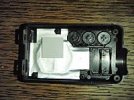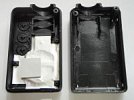BobDiaz
Well-Known Member
I decided to post the results of my tests on a new thread so that those who want to look this up later on can find all the information in one place. The first comments on my tests appear here:
http://dashcamtalk.com/forum/threads/the-mobius-heat-issues.2392/page-7#post-39156
The comments by murcod pointed out that my readings may be off on the metal due to emissivity of the polished metal surface. I did take readings from the plastic and found those to be higher than the metal.
http://dashcamtalk.com/forum/threads/the-mobius-heat-issues.2392/page-7#post-39156
I did try to see if the reading was higher at the high data rate compared to the low data rate, but in looking for the highest reading for both tests, I could see no difference in the temperature readings. The room temperature was 68F (20C) and the highest reading found was 105F (40.6C).
Here are the thermal images I've taken so far:


There are a number of additional tests I'll be working on to see the impact of different conditions... Stay Tuned.
Bob Diaz
http://dashcamtalk.com/forum/threads/the-mobius-heat-issues.2392/page-7#post-39156
The comments by murcod pointed out that my readings may be off on the metal due to emissivity of the polished metal surface. I did take readings from the plastic and found those to be higher than the metal.
http://dashcamtalk.com/forum/threads/the-mobius-heat-issues.2392/page-7#post-39156
I did try to see if the reading was higher at the high data rate compared to the low data rate, but in looking for the highest reading for both tests, I could see no difference in the temperature readings. The room temperature was 68F (20C) and the highest reading found was 105F (40.6C).
Here are the thermal images I've taken so far:


There are a number of additional tests I'll be working on to see the impact of different conditions... Stay Tuned.
Bob Diaz
Last edited by a moderator:



